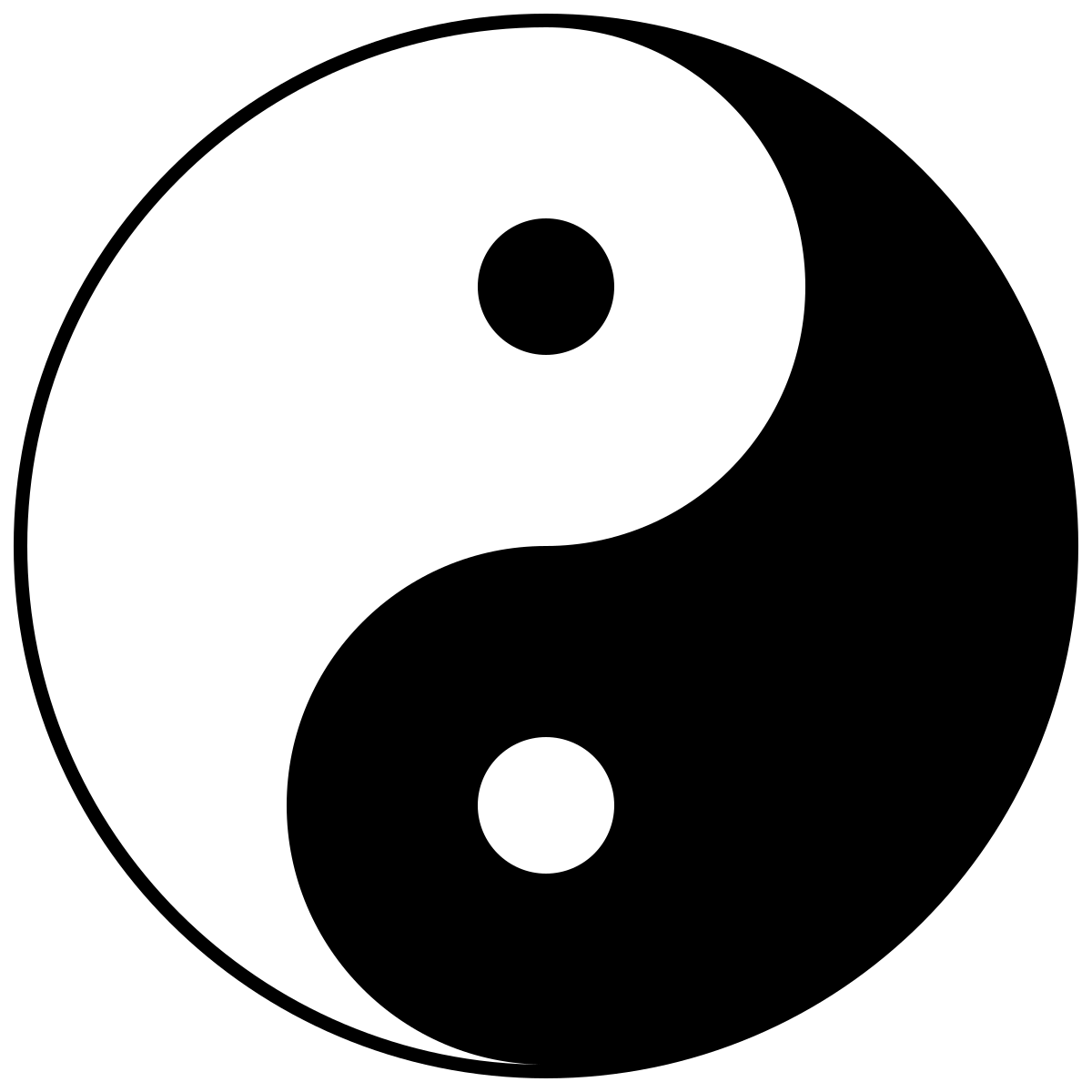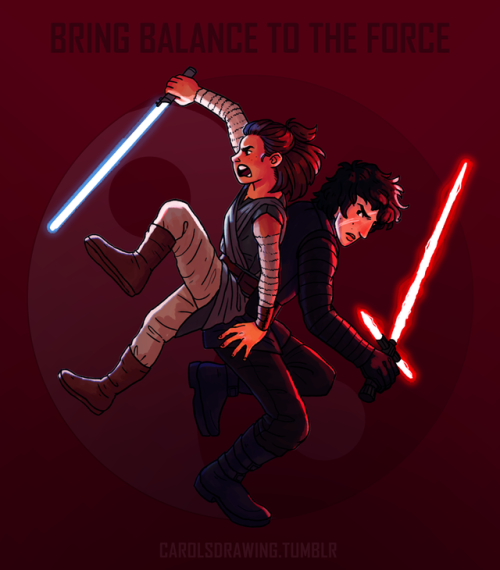I recently read Ursula K. Le Guin’s No Time to Spare, a collection of short essays. One of them, ‘Utopiyin, Utopiyang’, was about dystopian literature and its exploration of that balance, of yin and yang. Some of the essay’s quotes hit me as fitting incredibly well to The Last Jedi‘s exploration of the relationship between Rey and Kylo Ren, and I will be using those quotes as a jump-off point to discuss them. So, bear with me as I put down my thoughts and then please do let me know your thoughts in the comments!

The yin-yang is an ancient Chinese symbol, the name of which roughly translates to ‘bright-dark’, with ‘yin’ symbolising the light and ‘yang’ the dark. However, the very nature of the symbol implies that it is not that simple, that light and dark aren’t opposing forces that can be cleanly separated. Light and dark exist not just alongside each other, each contains something of the other as well. In dystopian fiction, such as 1984 and A Brave New World, the domineering regime is usually dominated by ‘yang’, by control rather than acceptance, violence rather than nature. This is an untenable position and therefore regimes like those will have to fall. They are unbalanced, they are unnatural. This is one of the key themes of Star Wars. The Empire is a clear example of an organisation led purely by ‘yang’, despising what is natural and receptive and favouring that which is harsh and restrictive. Yet this unbalance cannot continue and has to fail eventually. Thus, Storm Troopers, stripped of identity and encased in armour, are eventually defeated by rebels and Ewoks, natural and vulnerable. Similarly, as Chancellor Palpatine rises in power, the rebellion begins to take shape amongst senators like Amidala, Organa and Mon Mothma. This theme from the Originals and Prequels is continued in the Sequels.
Now, my desire to bring yin and yang to The Last Jedi isn’t purely inspired by Ursula K. Le Guin. The First Order is as restrictive as the Empire was. They have even taken it one step further with their Storm Troopers, ripping children away from parents and brainwashing them to become silent soldiers. But, as The Force Awakens and The Last Jedi showed us, when the power of the Dark Side rises, the Light rises to meet it. Rather than discuss First Order vs. Resistance, I’m going to stick with just Rey and Kylo, and how they together represent the yin-yang symbol. The notion that it had increased relevance came to during my first viewing of The Last Jedi, most notably during the scenes on Ahch-To set in the Jedi Temple/Cave. Unfortunately I couldn’t find a good picture of the pool in the Temple on Ahch-To, but the one below will give you an indication:

As you can see, there is a symbol under the water, one that combines black and white. During various moments in the film, it looked very much like the yin-yang symbol, or at least a version of it. Once I had that image in my mind, it very much coloured how I saw the developing relationship between Rey and Kylo. Time for a Le Guin quote:
‘In the yang-yin symbol, each half contains within it a portion of the other, signifying their complete interdependence and continual intermutability. The figure is static, but each half contains the seed of transformation. The symbol represents not a stasis but a process.’
It was clear from the beginning of the Sequels that Rey symbolised the light and Kylo Ren stood for the dark. But even in The Force Awakens it wasn’t quite that simple. Kylo Ren admitted to feeling the pull of the light and struggled visibly with killing Han Solo. And Rey, during their battle on Starkiller Base, shows a ferociousness and anger in her stance and fighting that Prequel-era Jedis would have gasped at. During their final fight they also, momentarily, seem to form a yin-yang symbol. This is continued in The Last Jedi. We see Kylo being unable to kill his mother and standing up to Snoke, while Rey terrifies Luke with her willingness to dive into the darkness and get answers. Kylo is not all bad, and Rey is not all good. They both carry, therefore, both light and dark in them, as well as the possibility to transform, to change. Kylo can become good, but Rey could also potentially become bad. It is an incredibly human message that we all carry the seeds of both good and bad within us, and that how we turn out depends largely on our choices.

Rey represents the ‘yin’, which is characterised by darkness, wet and cold. Considering where we find her in The Force Awakens this may seem anathema to her, but it fits perfectly with her bout of self-exploration in The Last Jedi in the Force Mirror Cave. Rey is receptive, but she is also concealed, to a certain extent, continuing her fitting to ‘yin’. Kylo represents the ‘yang’, which is characterised by warmth, control and activity. Again, this may not seem to fit in the first instance but it actually does. The bright light of his red lightsaber, his furious pacing and explosive anger, his deep desire to be in control of his emotions and destiny, these are all representatives of his ‘yang’-ness. Rey’s calmness clashes with Kylo’s temper, and yet The Last Jedi shows us how they fit together.
Snoke creates the mindlink between them, which has been hilariously dubbed Force-Skyping and ForceTime. He did so in order to exploit both their weaknesses, which are in a way symptoms of what they represent. He expected Kylo to not be able to hide his conflict, while he trusted Rey to be receptive to it. However, he significantly underestimated what their link would do. When they are first connected they are opposed to each other. Rey tries to shoot Kylo, while he tries to use his Force powers to control her. As they find it impossible to avoid each other, however, they open up. Rey’s emotions about Han Solo’s death and doubts about Luke come out into the open, while Kylo is, literally, stripped of his layers of darkness to reveal the human underneath. She allows him to open up, he allows her to explore her anger. When they touch hands on Ahch-To, there is a particular shot, when Luke walks in, where they almost form a yin-yang symbol themselves. He is draped in dark cloth, she is clothed in light material, yet they’re connected, cast in the same warm glow, creating something new together. Both have visions of the other’s future in which they envision a different world.
Their visions are seemingly diametrically opposed. Rey sees Kylo joining her, saving the Resistance and defeating the First Order. Kylo sees Rey joining him, ending the Resistance and ruling the First Order with him. Both see a new world created by them uniting on one side. As Rey confront Snoke, Kylo once again has to face some harsh truths and thereby, temporarily, opens himself up to more of Rey’s influence. He kills Snoke and together they fight the Praetorian Guards. And once again Rian Johnson gives us a shot of the two of them, perfectly balanced with each other. Rey leans on Kylo, Kylo gives her support, both fight off their opponents in a united effort. Despite standing on opposite sides, they can work together because they recognise something about each other.

So how does this co-operation end? In her essay, Le Guin talks about how most dystopian fiction focuses on regimes that overdose on ‘yang’, that seek to seem strong rather than open. When they have defeated the Guards, Rey wants to save the fleet while Kylo wants to continue with his plan to let everything end. He seeks control, still, while she still seeks to nurture and protect the good. Despite what they have in common, they are still opposed. For me, this was the moment in The Last Jedi that would define how I saw their relationship. Was one of them going to give in to the other? And if yes, how would that have fit with their character development? While Rey can recognise anger and disappointment within herself, she doesn’t relinquish herself to that part of her. Her transformation works at including her penchant for the dark in her search for wisdom and in her growth. Kylo also recognises the light in himself, but seems to completely identify that with Rey’s influence on him. He wants to incorporate her in his plans, without adjusting those plans to her and who she is. It reminded me of another Le Guin quote:
‘Yang, the dominator, always seeks to deny its dependence on yin.’
Could any statement be more relevant to Kylo Ren? Kylo doesn’t want to admit he has light inside him, rather he wants to co-opt Rey’s light and include it in his reign. And this is the clearest sign that no matter what has happened, they can’t be united yet. Kylo is still at war with himself, chasing that control he feels he needs. He feels the need to eliminate, or take over, everything that brings out the light in him. Hence Han Solo had to die. This is why he meant to kill Leia, even though he couldn’t, why he needs Rey to join him rather than the other way around. He can’t even accept his old name, whereas Rey has begun to accept who her parents were. He is still very much on the path to reconciling himself with who he is, whereas Rey is nearing the end of that path.

In The Last Jedi both Rey and Kylo explore their own moral make-up, what they want, who they are, what they are to each other. They are two parts of a single symbol, but despite their similarities and their connections, they are still separate. Neither can give in to the other without losing something that is currently essential to them. The Last Jedi sets them on a path of exploration and self-discovery but doesn’t give it a cheap, “happy” ending. Rather, the film leaves it open to the future. And by that I don’t mean it leaves open the door for a romantic relationship only. Sure, it does that as well, there are definitely hints it could happen. But I think the film is a much clearer set up for co-operation between them. So how will Rey and Kylo continue their journeys? Rey leaves Kylo to himself in the end of the film, leaving him to figure himself out the way she has, to confront that part inside of him he doesn’t want to see the way she has. The Last Jedi uses the symbol of yin-yang to contextualise their growing relationship without betraying their character development, and personally I can’t wait to see how this is continued in Episode IX.
Do you agree with the links to yin-yang that I saw? And how do you think this will develop in the next film?
Want to read more? Check out our character studies from The Last Jedi:


I don’t buy it. I find it difficult to perceive that two individuals are supposed to personified different “sides” of the Force.
I’m not that keen on the relationship between the two characters in the first place.
I found it rushed, disturbing and misplaced. I also feel as if this relationship is being shoved down our throats by Lucasfilm and Rian Johnson.
But the idea that each of them only personify one particular facet of the Force does not work for me. It’s like someone trying to compartmentalize nature itself via different living beings. Or that individual living beings represent or possess one aspect of nature. I find that hard to accept.
LikeLike
Kylo ren is yin of yang, rey is yang of yin, both are the rebellion of their original nature, may be that rey is the princess palpatine
LikeLike